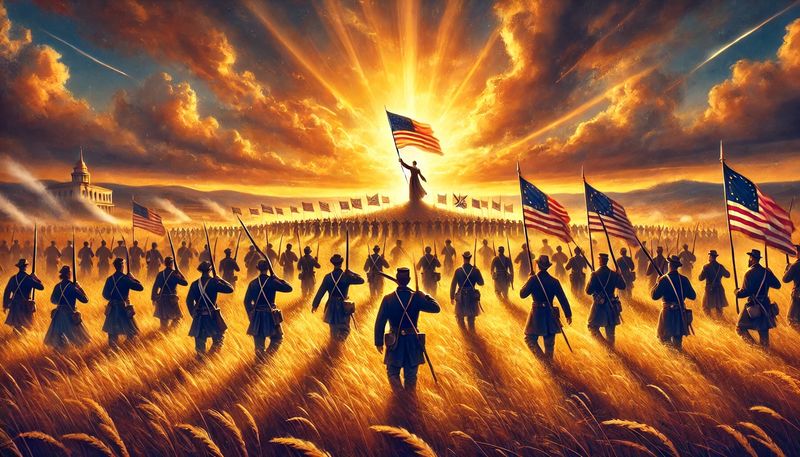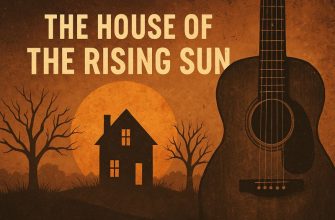The “Battle Hymn of the Republic” is more than just a song; it’s a resonating piece of American history. I’ve always been fascinated by the way this hymn bridges the gap between the past and the present. Today, let me take you on a journey through its origins, meaning, and enduring legacy.

The Story Behind the Song
The “Battle Hymn of the Republic” was penned by Julia Ward Howe in 1861 and first published in 1862 during the height of the American Civil War. Howe was inspired to write the lyrics after visiting Union troops near Washington, D.C., where she heard soldiers singing “John Brown’s Body,” a marching song about the abolitionist John Brown. Recognizing the power of the melody, Howe’s companion suggested she create more uplifting and poetic lyrics to match the tune. That night, as the story goes, she awoke from a burst of inspiration and quickly jotted down the verses that would become the “Battle Hymn of the Republic”.
Set against the backdrop of a nation divided, Howe’s lyrics transformed the song into a rallying cry for the Union cause, weaving biblical imagery with themes of justice, faith, and freedom. This hymn wasn’t just a song; it was a symbol of hope and resilience for a fractured country.
Interestingly, the original version of the “Battle Hymn of the Republic” consisted of six stanzas. However, in many modern performances, the sixth stanza is often omitted, leaving the hymn with five verses. This change is likely due to the practicalities of performance length and the lesser-known nature of the final verse.
The Meaning and Themes
At its core, the “Battle Hymn of the Republic” is about the relentless march of truth and justice. Its opening lines, “Mine eyes have seen the glory of the coming of the Lord,” set the tone for a song steeped in religious conviction. Howe’s words frame the Union’s struggle as a divine mission, aligning their cause with a higher purpose. The hymn’s themes of sacrifice, redemption, and unwavering faith have made it timeless and universally resonant.
The refrain, “Glory! Glory! Hallelujah!” is a powerful affirmation that’s impossible to forget once you’ve heard it. It’s a chant that has echoed across generations, imbuing listeners with a sense of purpose and unity.
Lyrics to “Battle Hymn of the Republic”
[Verse 1]
Mine eyes have seen the glory of the coming of the Lord:
He is trampling out the vintage where the grapes of wrath are stored;
He hath loosed the fateful lightning of His terrible swift sword:
His truth is marching on.
[Chorus]
Glory! Glory! Hallelujah!
Glory! Glory! Hallelujah!
Glory! Glory! Hallelujah!
His truth is marching on.
[Verse 2]
I have seen Him in the watch-fires of a hundred circling camps,
They have builded Him an altar in the evening dews and damps;
I can read His righteous sentence by the dim and flaring lamps:
His day is marching on.
[Verse 3]
I have read a fiery gospel writ in burnished rows of steel:
“As ye deal with My contemners, so with you My grace shall deal;
Let the Hero, born of woman, crush the serpent with His heel,
Since God is marching on.”
[Verse 4]
He has sounded forth the trumpet that shall never call retreat;
He is sifting out the hearts of men before His judgment-seat:
Oh, be swift, my soul, to answer Him! Be jubilant, my feet!
Our God is marching on.
[Verse 5]
In the beauty of the lilies Christ was born across the sea,
With a glory in His bosom that transfigures you and me:
As He died to make men holy, let us die to make men free,
While God is marching on.
[Verse 6]
He is coming like the glory of the morning on the wave,
He is wisdom to the mighty, He is succor to the brave,
So the world shall be His footstool, and the soul of time His slave,
Our God is marching on.
[Chorus]
Glory! Glory! Hallelujah!
Glory! Glory! Hallelujah!
Glory! Glory! Hallelujah!
His truth is marching on.
Musical Characteristics
The “Battle Hymn of the Republic” is set to the tune of “John Brown’s Body,” a melody that was originally a camp meeting song. Its structure is simple but effective, making it easy to adapt and perform in various musical styles. Traditionally sung in a marching tempo, the song’s steady rhythm mirrors the determination and resolve found in its lyrics.
In its original form, the hymn blends elements of folk and gospel music. Over the years, it has been reinterpreted in styles ranging from solemn choral arrangements to lively country and bluegrass renditions. The adaptability of the melody and its universal themes have allowed it to transcend musical genres and reach new audiences.
I’ve experimented with integrating contemporary sounds—from subtle electronic beats to atmospheric instrumentation—to give this hymn a fresh edge while preserving its essence. The beauty of the “Battle Hymn of the Republic” lies in its versatility, and I’ve found that each interpretation reveals a new layer of its emotional depth.
Cultural Significance and Legacy
The “Battle Hymn of the Republic” became an anthem for the Union during the Civil War, embodying the fight against slavery and the hope for a united nation. Its popularity didn’t wane with the war’s end; instead, it evolved into a broader symbol of American values and ideals.
The hymn has been performed at countless historical moments, from presidential inaugurations to civil rights marches. Martin Luther King Jr. famously quoted its lyrics in his speeches, further cementing its place in the American consciousness. Its adaptability to various causes and movements highlights its enduring relevance.
Fascinating Facts
- Connection to “John Brown’s Body”: The melody of the “Battle Hymn” originally belonged to a song about John Brown, the abolitionist whose raid on Harpers Ferry became a flashpoint for the Civil War.
- Historical Performances: The hymn was performed at the funerals of notable figures such as Winston Churchill and Robert F. Kennedy, signifying its global and cross-generational appeal.
- Pop Culture Appearances: Over the years, the “Battle Hymn of the Republic” has been featured in films, television shows, and commercials, including its stirring rendition in “Glory,” a film about the 54th Massachusetts Infantry Regiment.
Modern-Day Resonance
Even today, the “Battle Hymn of the Republic” remains a staple of patriotic celebrations, church services, and public events. Its stirring message of faith and perseverance continues to inspire. Younger generations encounter it in new contexts, from video montages to remixes, proving that its legacy is far from fading.
For me, as “American Bard,” this song epitomizes the power of music to connect us to our roots while encouraging us to innovate. By blending traditional melodies with modern techniques, I strive to breathe new life into pieces like this, ensuring they remain relevant and vibrant for years to come.
I invite you to join me on this journey. Check out my renditions of the “Battle Hymn of the Republic” on YouTube:
Song: Battle Hymn of the Republic (Standard Edition 🇺🇸) | Short Version 5-verse
Battle Hymn of the Republic (1861 Original Edition) | Full Version 6-verse
Subscribe to my social media channels for more reimagined classics. Together, we can celebrate and preserve the rich heritage of American music, one song at a time.
- The Battle Hymn of the Republic — Song of America. Version of the song with 6 verses.
- The Battle Hymn of the Republic | Mine eyes have seen the glory of the coming of the Lord | By Julia Ward Howe (1819–1910), *The Battle Hymn of the Republic*, written in 1861, first published in 1862 (checked against a primary source).
- The Atlantic Monthly/Battle Hymn of the Republic – Wikisource. Original publication in The Atlantic Monthly.
- The Battle Hymn of the Republic: A Primary Source Starter | Teaching with the Library of Congress| Details about the origin and cultural significance of the hymn.
- Battle Hymn of the Republic – Wikipedia| History, cultural impact, and analysis of the song.
- The Story of the Battle Hymn of the Republic – Library of Congress| Description of the history and significance of the hymn.



